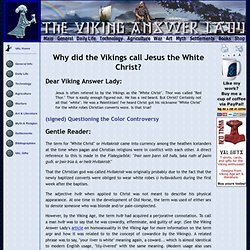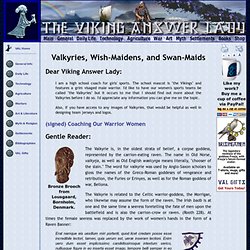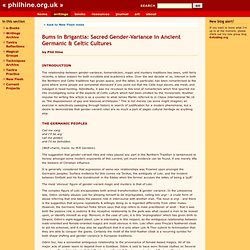

Why did the Vikings call Jesus the White Christ? Dear Viking Answer Lady: Jesus is often refered to by the Vikings as the "White Christ".

Thor was called "Red Thor. " Thor is easily enough figured out. He has a red beard. But Christ? (signed) Questioning the Color Controversy Gentle Reader: The term for "White Christ" or Hvítakristr came into currency among the heathen Icelanders at the time when pagan and Christian religions were in conflict with each other. That the Christian god was called Hvítakristr was originally probably due to the fact that the newly baptized converts were obliged to wear white robes (i hvítaváðum) during the first week after the baptism.
The adjective hvítr when applied to Christ was not meant to describe his physical appearance. However, by the Viking Age, the term hvítr had acquired a perjorative connotation. It was during this period of conflict between religions that amulets of Thórr's hammer, Mjollnir, increased in popularity as ornaments,perhaps in response to Christians weraing the symbol of the cross. Valkyries, Wish-Maidens, and Swan-Maids. Dear Viking Answer Lady: I am a high school coach for girls' sports.

The school mascot is "the Vikings" and features a grim visaged male warrior. I'd like to have our women's sports teams be called "the Valkyries" but it occurs to me that I should find out more about the Valkyries before I do so. I'd appreciate any information you can give me on the topic. Also, if you have access to any images of Valkyries, that would be helpful as well in designing team jerseys and logos.
(signed) Coaching Our Warrior Women Gentle Reader: Women and Magic in the Sagas: Seiðr and Spá. I.

Introduction The Norse practitioners of the various arts of magic were highly respected professionals whose services were valued by their communities (Jochens, Old Norse Magic and Gender, 307; Ellis-Davidson, 37). In the Norse literature, men as well as women appear wielding the arts of magic, however, it is explicitly stated in several places that by doing so these men were taking on a female art so thoroughly that it endangered their reputation and manhood (Ynglingasaga, ch. 7, for instance).
Since Norse magic was so intrinsically a woman's art, throughout this paper I will deal with magic as practiced by women, using the feminine pronoun, but it should be remembered that men as well as women practiced the art as recorded in the sagas. Many of the most important cult practices of the pagan Norse religion occurred in the housewife's domain, where the woman of the house would act as priestess or gyðja (Steffensen, 191).
II. Seiðr Spá Galdr Runic magic III. IV. V. Homosexuality in Viking Scandinavia. Dear Viking Answer Lady: How did the Vikings regard and treat male and female homosexuals?

I am considering adding a blue feather to my Viking garb, but I wonder how this will affect my persona? (signed) They Call me Strange Oddi Gentle Reader: My personal research into homosexuality in the Viking Age shows clearly that the Vikings had words (and therefore mental constructs and concepts) of same-sex activity; however since the needs of agricultural/pastoral living require reproduction not only to work the farm but also to provide support for the parent in old age, it was expected that no matter what one's affectional preferences were that each individual would marry and reproduce. Bums in Brigantia: Sacred Gender-Variance in Ancient Germanic & Celtic Cultures. The relationship between gender-variance, homeroticism, magic and mystery traditions has been, until fairly recently, a taboo subject for both occultists and academics alike.

Over the last decade or so, interest in both the Northern and Celtic traditions has grown apace, and the latter, in particular, has been romanticised to the point where some people are somewhat dismayed if you point out that the Celts kept slaves, ate meat, and indulged in head-hunting. Admittedly, it was my revulsion to this kind of romanticism which first spurred me into investigating some of the aspects of Celtic culture which had been omitted by the revisionists.
Another impulse for writing this article is as a counter to what James Martin referred to in Chaos International No.16 as "the dispossession of gay and bisexual archetypes. " Call me varg and I'll be arg call me golden and I'll be beholden. (Wolf-charm, transl. by M.R Gerstein) Margaret C. Diodorus Siculus (1.BCE) Transgression & Transformation.